Category: Cambodia
You are viewing all posts from this category, beginning with the most recent.
Sixty Minutes of Inspiration
Sixty Minutes of Inspiration
Today was another one of those days that was thought-provoking, uplifting, and inspiring. This morning we had a new guide, who took us to his own village and showed us his own house. That experience will be a part of a post that has been brewing for a week or so. I’m going to do this one first as it is fresh in my mind.
We just got back from JWOC (yes, they pronounce it jay walk) which stands for Journeys Within Our Community. What a great experience! We didn’t really know a lot about what we were in for this afternoon, other than we were there to volunteer in a class, and it would involve speaking english. So far, so good.
Before I tell you about the class, and what we did, I want to give you a little background about JWOC and the educational system here in Cambodia. The latter is easy. Its pretty minimal. Students may go to school from ages six to fourteen. After that there is really not much for them. Students may go to a private school for further education, but they are pretty expensive for most people in Cambodia.
JWOC has programs in five key areas: Community Assistance, Clean Water, Microfinance, Free Classes, and Scholarships. The scholarship program is the heart of it all. Since 2005 JWOC has provided 120 scholarships for students to get a university education. However, these students must in turn give back by volunteering their time on another JWOC program. The instructor of the class we participated in this afternoon was one such student.
At the JWOC center in Siem Reap they have students from age 4 all the way to 60. The classes are open to anyone in the community and range from english, to sewing, to gardening, to computers. The class we worked with was a hospitality class. You can think of it as an enrichment course for students who are interested in improving their english so they can work in the hospitality industry. One student wanted to be a hotel receptionist, another told us he wanted to be guide.
We started out the class with everyone introducing themselves. There was much smiling and laughing and clapping as we went around the room. Their enthusiasm was infectious. After the intros we moved on to some role play1. The instructor paired us up, and I played the role of a tourist who wanted to book a room, while my student played the role of someone at the front desk of hotel. I had a list of features that I wanted in my room and he had information about what they had available and the associated prices. He was into it! First he had to clarify several points with the instructor, and then we started out. After working our way through a fairly lengthy conversation, he said. “We need to do this again. We need to be the best so that we can perform for the class.” So we did it again.
When the teacher asked for volunteers to do their role play for the class I think he might have been a little disappointed that there was no choice based on merit, but he was undaunted and quickly volunteered us for the job. Here we are in the front of the classroom playing our roles:
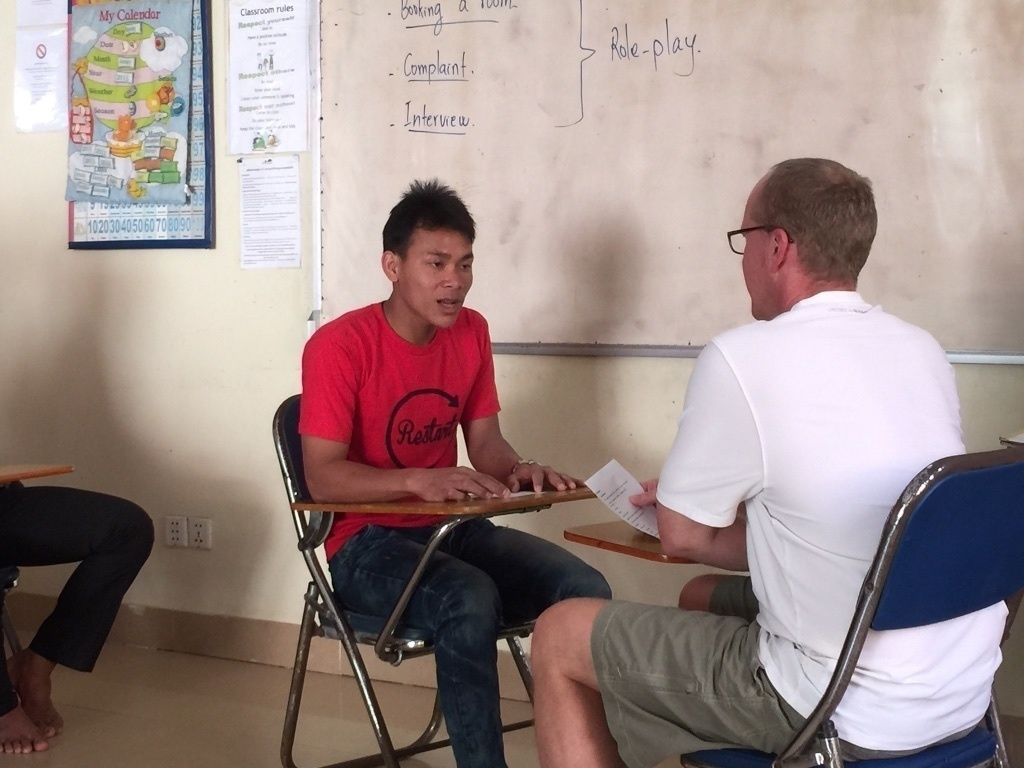
Jane also had an excellent student, that I wish I could have talked with some more. He wants to be an engineer, and is enthusiastically studying math and physics.
After the role playing was done we had about 20 minutes for free conversation. They divided the class in two, and put each of us with one group. The instructor said that since I was a professor they could ask me about anything. No pressure. We were all grinning from ear to ear even though they were a bit shy about asking questions. They wanted to know about where I was from, and what kind of crops we had, which led to a little discussion about how cold it is in Iowa. One of them was wearing a Chelsea shirt so that led to some quick conversation about football. Then I asked about what I should see or things I should eat. I think they were all impressed when I said we had already tried Amok and Lak Lok.
One student had been holding back and I could tell he wanted to ask me something, but he said he was to embarrassed. With a bit of coaxing he finally asked me: “what good are computers?” Well, now that is a question. Nobody laughed at him for asking it. What good is something that I take for granted and use all day everyday? So we talked about how you could use computers to learn things, anything you wanted to know you could find out. Only one of the students in my group had heard of Google! We talked a little about their markets and how they bought everything they wanted at the local market. I tried to describe how I used the computer to do my shopping. I can buy anything I want on the computer and a truck brings it to my house in two days. I may just as well have sprouted a second head.
Our hour was over in no time. But we left with such respect for these students. They were so enthusiastic and supportive of each other. It was a class like nothing I’ve experienced before.
Afterward we had a chance to talk with the education coordinator here in Siem Reap. She is an American from Connecticut who has been here about five months and had some nice insights to share with us. It is true that these students value education in a very different way because it is so special. She told us about the collaborative nature of the Cambodian culture and how important that is to their educational experience. Something that I never would have really understood before spending time here. But I’m glad that I did.
Here is the class with all of us all together.

-
Some great irony here as I’ve been known to skip out of faculty meetings where role playing is on the agenda. ↩︎
Siem Reap Cycling
Siem Reap Cycling
“Those stairs are too steep,” said our guid Sina. Those stairs must be climbed I said to myself. We were only about an hour into our afternoon of bike riding when we came across this out of the way temple. The staircases are at about a 60-70 degree angle to force people to focus on their climb to the top. We had been looking at these all day at various temples, but in each case the authorities had helpfully built a wooden staircase at a much more gentle angle. Out here away from the crowds was a chance to try the real thing. So, we rode around the back, there were identical stairs on all four sides, and I stopped my bike. “Just a few?” I asked? OK, So I quickly climbed up about 10 or 12 stairs. With a smile and a gesture Sina told me it was OK to continue as far as I wanted, which was all the way to the top.
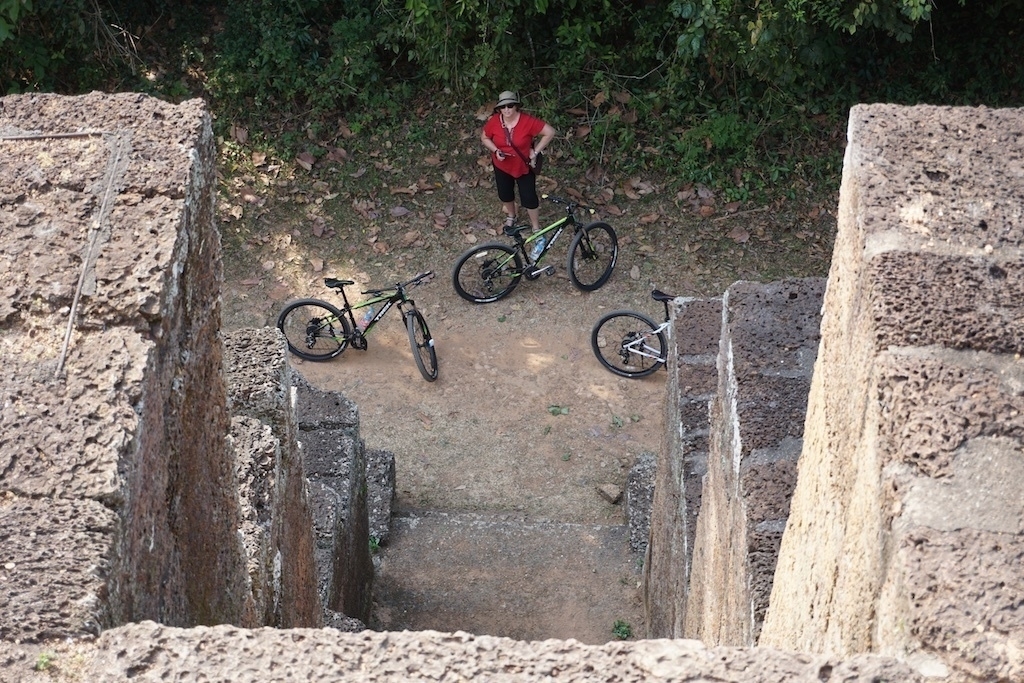
|
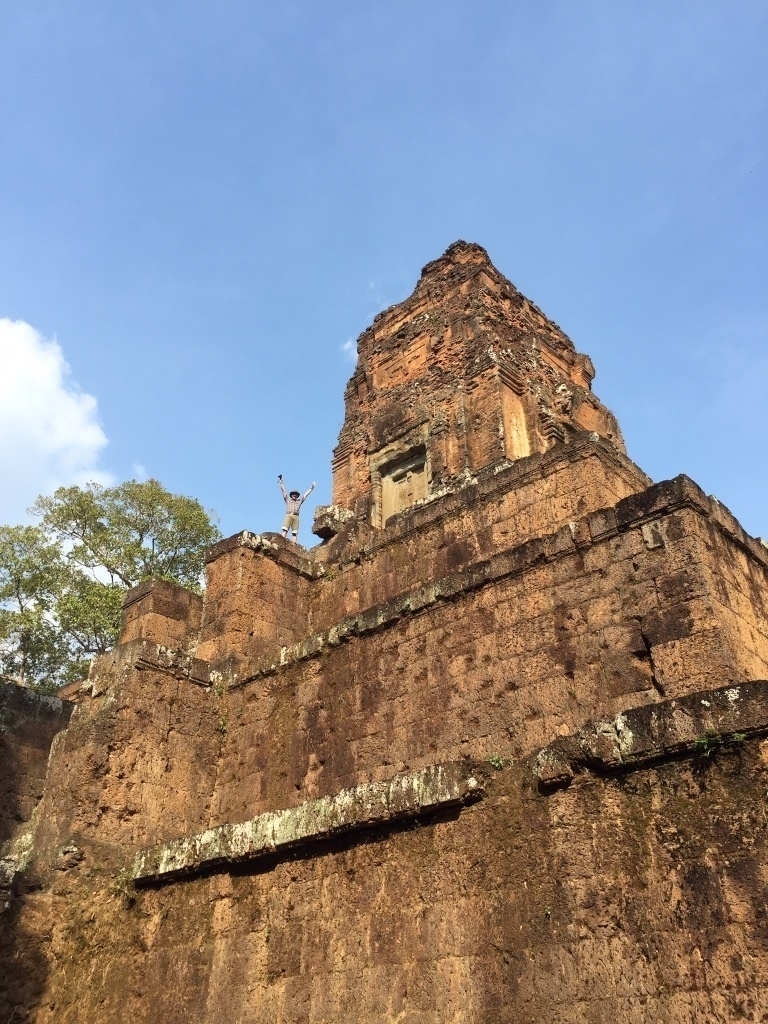
It turns out that this was just the beginning of a great afternoon of adventures on our rented mountain bikes. The bikes allowed us to get to places of the giant temple complex that most people don’t go to because its a long walk on paths that are not very well marked.
You carry your bike through a dry creek bed and an ancient door on the other side and you are treated to another amazing site. Way in the far back of the temple we did some serious mountain biking, and climbing. Even our guide asked us to take a picture of himself on his bike to show his friends. Actually I think he posted it on Facebook immediately. Look where I took the crazy Americans today! This was toward the end of our ride, so you can see some of the amazing golden colors of the late afternoon sun.
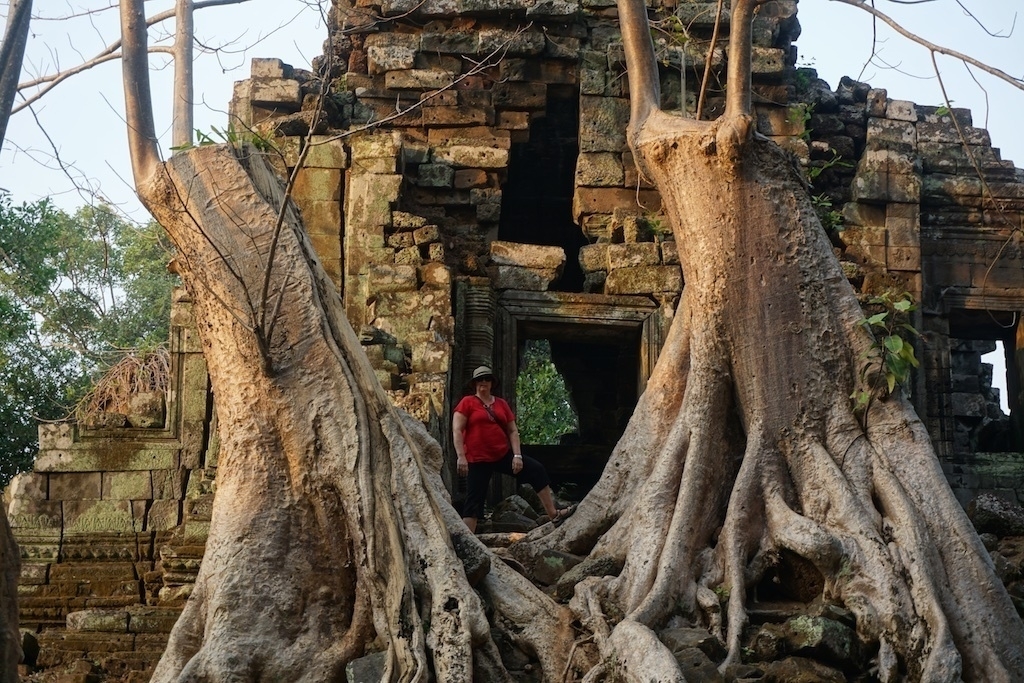
|

One place we did get off the bikes and walk around was at the Bayon temple. This was built by King Jayavarman VII. Yeah, I can’t say it either -- even after hearing our guide say it several times. We ended up just going by seven. My favorite was Udayadityavarman I who predated VII by about 80 years. Anyway, Jayavarman VII was a very long lived king, and a very good king. He built many temples, and took care of the people. They have a children’s hospital in Siem Reap named after him.
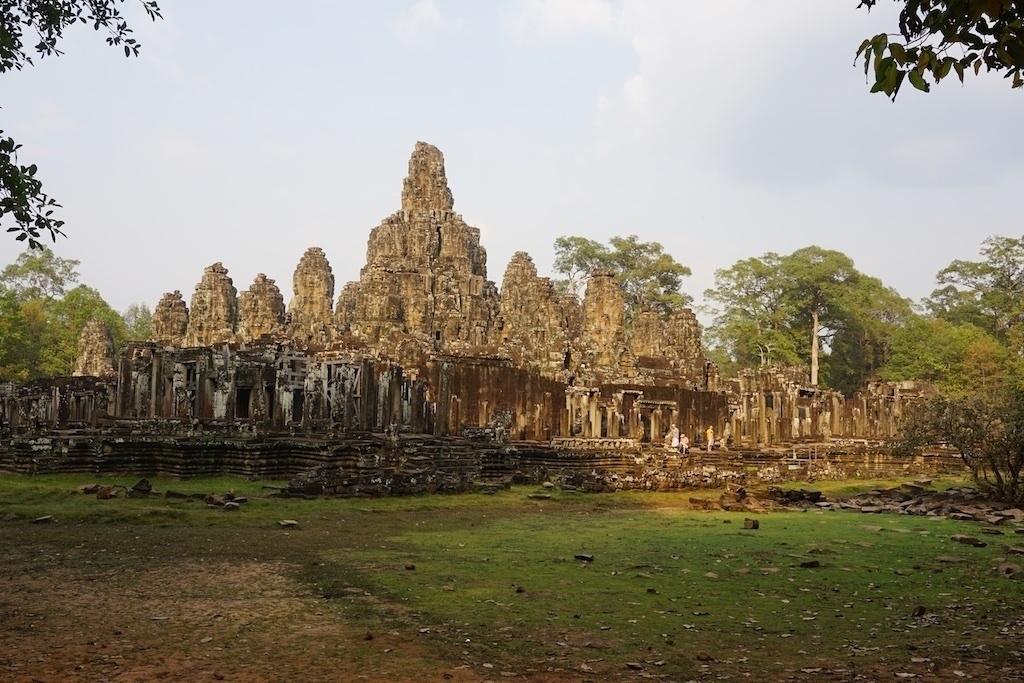
As you are walking through the temples with the guide it is really interesting to hear about the history. Many of the temples were originally built as Hindu temples and then later converted into Buddhist temples. Some are the other way around, it just depended on who was in charge at the time they were built.
Most of the temples we visited were built between 950 and 1180. At some point most of them were abandoned and fell into ruin until they were rediscovered largely by the French in the early 1900’s. Of course some of the discoverers were corrupt and tried to loot the temples and sell off the amazing bas relief stone carvings back home. But others financed the beginnings of the restoration of these places.
Every one of those towers in the Bayon temple has the face of Jayavarman VII on four sides. It is said that this symbolizes that the king was watching everything and everyone at all times.
Because the Cambodian government is quite corrupt, and it is quite a poor country, many of the restoration projects we saw over the last few days were financed by other countries. Some by Japan and Korea, to provide a great tourism experience for their people, others by India and other countries for maybe more altruistic reasons.
One other bit of excitement for the day happened when we made a comfort stop. It turned out the elephants were headed to the same place.
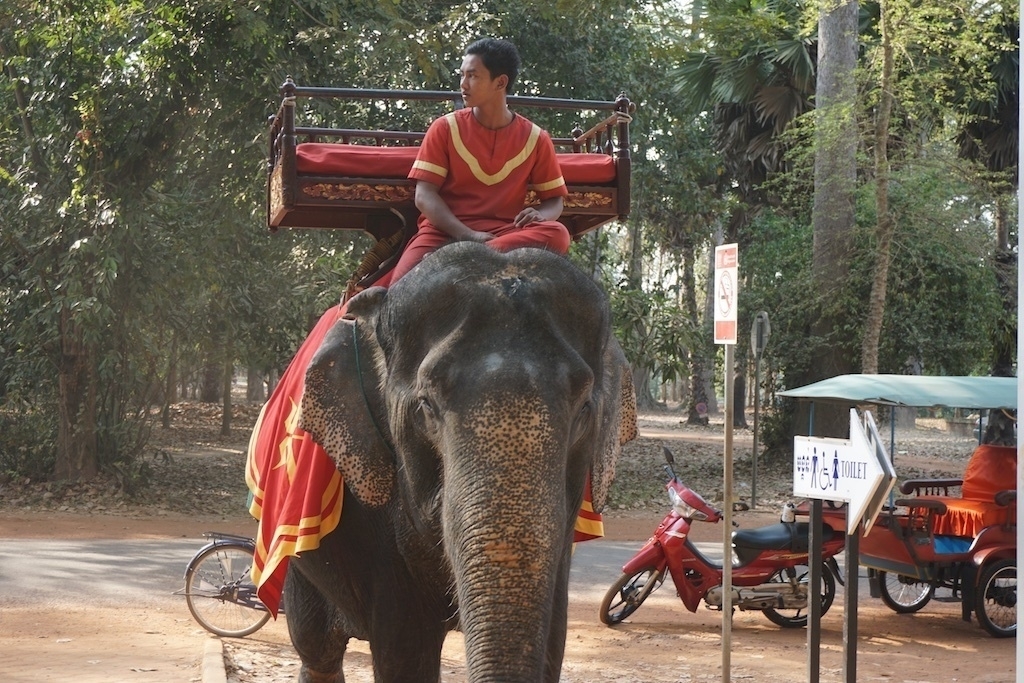
Early Morning Temple
Early Morning Temple
Wake up call, 4:30 a.m. Oh-dark-thirty as some would say. After a full day of travel yesterday, from Halong Bay, and a crazy arrival process in Siem Reap, we started our first full day in Cambodia plenty early. Our guide and driver met us at reception at 5 a.m and we headed for Angkor Wat in the darkness. We wanted to get a good spot to watch the sun rise behind the temple. When we got there the moon was still up and it was pitch dark. But as we sat and got to know our guide a bit, we began to see a shadow of the temple emerge from the dark sky. Gradually, the day dawned, and the clouds reddened and the temple became fully visible.
It was worth the short night to join the throngs of other people and see the sun come up. As we sat and began to wonder if we would see our friends Ann and Jerry among all of the other people there, Jane suddenly said “is that Jerry?” Then a moment later she spotted Ann and we started waving. So right there we had a little reunion with our friends and traveling companions. Since it was the right time, Jerry and I did an abbreviated workout in honor of our P90X buddies back home.

We each had to go on our way for the day, Jerry and Ann with their Luther Students in tow, and us with our Guide Sina to visit the temple. We will meet up with them for dinner in town tonight.
Right now we are resting after being at the temple for about 4 hours. We’ll meet our guide again at 1:00 for lunch and a bike ride to the Angkor Thom temple.
Lifestyle Reflections
Lifestyle Reflections
Note: I wrote the first part of this post as a draft, while in Cambodia, and then forgot to “un-draft” it. So I just realized four months later that it has not been finished or published. I will finish and publish it now.
Some of my earliest memories are of a small house in a small town in Southwestern Minnesota in the late 1960’s. My Grandma Sundahl lived in this house. As you came in the side door, you could turn left and go up a few stairs to the kitchen, or straight down the stairs to the basement. The basement had three rooms, a laundry room off to the left as you went down the stairs. I remember big crockery bowls on the counter in that room and a big black adding machine that we could play with endlessly. To the right was a cinder block room with a cement floor. Grandma had painted the walls and decorated them with big posters of the Campbell Soup kids. There was a ping pong table at one end. As far as I can remebmer the other end of that room was open for us to run around in. Straight ahead as you reached the bottom of the stairs was the big dark scary room. there was a shower in there, that I never really wanted to shower in. This was also the room where Grandpa Sundahl’s tools were.
In the kitchen the sink was straight ahead as you entered with a window to the back yard yard. I remember using the hand mixer in that sink hundreds of times to make more bubbles out of the dish soap. To the right of the sink was a stack of shelves. The third door down was the magic drawer. There was always a package of M&M’s for each of us, and this was where Grandma kept the matches for her cigarettes, which we hid endlessly. Behind the sink was the gas stove and refrigerator. A felix the cat clock was on the wall over the small kitchen table.
In the living room was a black and white television. If we wanted to watch Rocky and Bullwinkle we would have to turn the rotor to point the antenna towards Sioux Falls in the west. Sadly, Lawrence Welk was non-negotiable and required the rotor to point the antenna towards Mankato in the Northwest.
The upstairs was my personal kingdom. The stairway divided the small dormer style upstairs room into two halves. There was a half-wall around the stair to keep you from falling, and we would endlessly pile up grandma’s pillows on a blanket that we stretched across and over the stair. We would call grandma to come upstairs and then drop the pillows on her. Amazingly she never caught on.
In Storden we were allowed to walk anywhere on our own. We could go to Witt’s grocery store and get groceries for grandma, and of course a pushup, or some other ice cream treat for our efforts. As far as I remember no money was exchanged everything was done on account. Down the road from the grocery store was the elementary school with swings, teeter totters, and of course the tall metal slippery slide with a big hump in the middle. Nothing was made of plastic in those days, there were no soft recycled bits of anything to land in at the bottom of the slide.
You may be wondering why I’ve just written four paragraphs of memories about small town Minnesota life in the late 60’s when I’m in the middle of Cambodia. Actually I’m a bit surprised myself, but once I started, the memories kept following one after the other, and it seemed right to get them down. Maybe this blog needs a good editor! Still, its a valid question.
I’ve been thinking a lot about those early days as I’ve been traveling through Vietnam and now Cambodia these last few weeks. Its not a conscious effort on my part, the memories just keep arising as we drive around.
My learning style is to make connections between things I know and the things I’m learning. I find patterns, and make associations. You may be wondering what connections and parallels I see between Southwest Minnesota and the Southeast Asian countries of Vietnam and Cambodia. To me the parallels are obvious.
For me, these memories of my childhood represent a simple “make do” style of living. We had fun, but it wasn’t expensive and it wasn’t complicated. Later in life I learned that my Mom, the oldest child, and grandma and grandpa had lived in the basement for a period in order to save the money to build the rest of the house.
### Here we pick up the thread several months later
After four months in Malta and around the Mediterranean, I think I understand why I was writing a lot of what I wrote. I comes down to thinking about your own lifestyle. The stark contrast in January between my own lavish lifetyle and the lifestyle I’ve lived in Malta these last four months is pretty amazing. I have learned to live with a lot less than I do at home, I have learned to enjoy cooking and eating even without my gourmet kitchen, I have accomplished a lot of development work on projects that I am truly passionate about with nothing but a laptop and an internet connection.
The flat we live in was built in the 1950’s probably a decade after the house in Storden was built. There is almost nothing in common between this long narrow limestone flat, and the house in Storden other than the shared experiences of the members of the generation that built each structure.
One of the interesting things about Malta is that the tension between the generations is more evident to me on Malta than it is in my own country. There is a real sadness among the older generation about how the island has changed in the last 30 years, and i guess I honestly can’t say how the younger generation feels, but I can observe their actions as they overbuild, and overuse the limited resources available to them on the island.